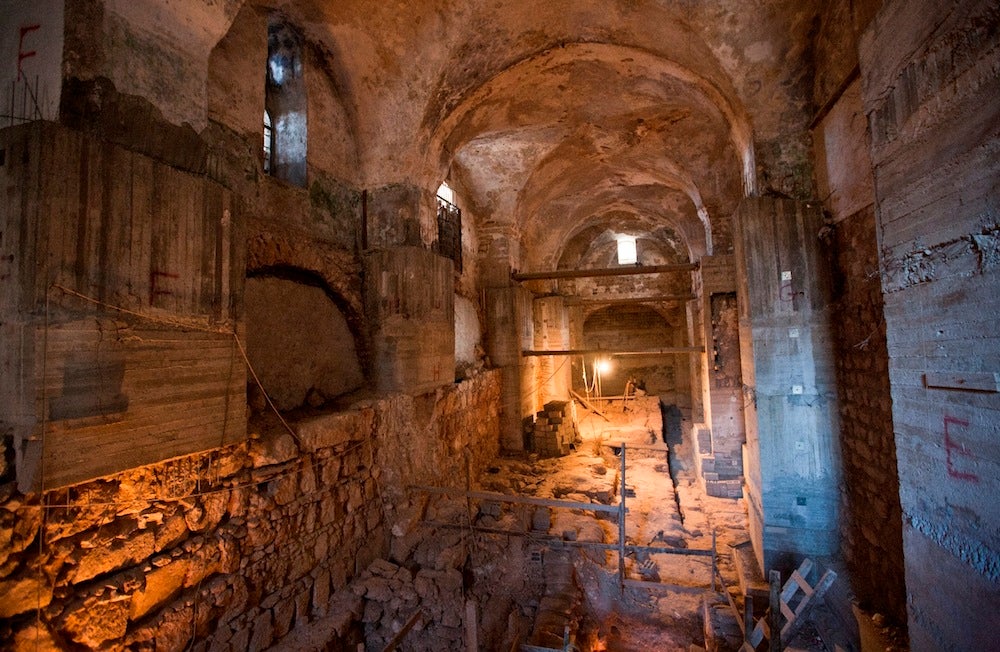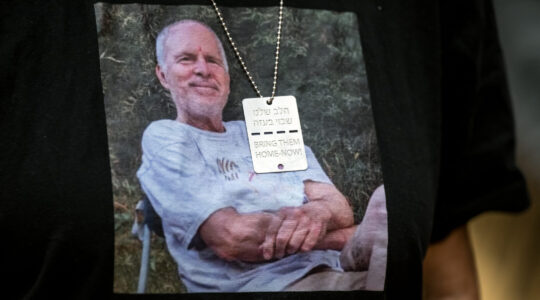
Beneath a former Ottoman prison in Jerusalem’s Old City, layers of ancient history were uncovered. (Hamutal Wachtel)
JERUSALEM (JTA) — When Amit Re’em embarked on a 1999 excavation of an abandoned Ottoman prison in the Old City of Jerusalem, he didn’t expect anything revolutionary.
The dig was primarily aimed at inspecting the site before it was transformed into an event space for the nearby Tower of David Museum, and Re’em, then just 28, hoped at most to uncover some remains of a Herodian palace, or maybe part of a wall from the second century.
He did find those things — along with much more.
In one 160-by-30-foot space, Re’em unearthed an archaeological timeline of Jerusalem dating back 2,700 years. Layers from nearly every era of the city’s history lay on top of each other, from the time of the First Temple through the Roman, Crusader and Ottoman periods, and up to Israel’s independence in 1948.
Remains from those eras are strewn throughout the Old City, but rarely are they found so close together or so well preserved.
“The strength of the remains and the layering of them one on top of each other is like an open book, the whole historical and archaeological sequence of Jerusalem laid out in front of our eyes,” Re’em told JTA. “We expected to find things, but the strength that we saw them in was beyond our expectations.”
Called the Kishle — Turkish for prison — the site was built as a jail by the Ottoman Turks in the 1800s and used by the British in the 1940s to hold captured Jewish militia members. A map of Greater Israel etched by an imprisoned member of the prestate Irgun militia is still visible on the wall.

The entrance to a former Ottoman prison known as the Kishle in Jerusalem’s Old City. (Oded Antman)
Below the prison lay the foundations of a fortification wall built in the eighth century B.C.E. by the ancient Jewish King Hezekiah, who like later rulers took advantage of the site’s strategic high ground. Across the room are remains of another defensive wall built 600 years later by the Hasmoneans, who ruled Jerusalem after the Maccabees revolt.
The room also houses remains of the wall of a massive Herodian palace built near the beginning of the Common Era, as well as basins from the Crusader period that were likely used to dye clothes and tan leather. The current walls of the Old City, built by the Ottomans in the 16th century, sit atop the Herodian wall and later served as the outer wall of the prison.
Re’em also believes the room may have been the site of Jesus’ trial by Pontius Pilate. Pilate would have tried Jesus in a prominent location like Herod’s palace, Re’em said, noting that the original route of the Via Dolorosa that Jesus followed to his crucifixion passed the spot where the Kishle now stands.
“A lot of times you expect something and don’t find it because you didn’t get down to the lower layers because of logistics, budget, you name it,” Re’em said. “On the other hand, archaeological layers and remains are [sometimes] destroyed. Here we were lucky the remains weren’t damaged or destroyed. We could dig for two years from the top down to the bottom.”
Re’em’s findings convinced the Tower of David Museum not to build on the site. But since the dig ended in 2001, the room remained closed due to budget constraints until the museum’s new director, Eilat Lieber, opened it to the public last year.
The room has not been changed since 2001 and looks like an active archaeological dig. Lieber hopes to place a glass floor above the remains and to augment them with 3-D imaging that will show what the space looked like in different periods.
“It’s like a hello from different historical eras that connect us to this place and allow us to understand what was here,” Lieber told JTA. “What remains are stones, but behind the stones are what was here, who the characters were.”
Many of Re’em’s conclusions about the room are based on dating techniques and inferences from historic sources. The claim that the walls belonged to Herod’s palace come in part from the writings of the historian Josephus Flavius. Re’em’s belief that the basins were used for cloth dying is derived from an account by Benjamin of Tudela, a medieval Jewish traveler, plus remnants of red dye on the basin walls.
But Re’em added that at a certain point, dating and accuracy become less important than what the site means to visitors looking for a spiritual experience.
“As an archaeologist who works in Jerusalem, it doesn’t matter where the real location of Jesus’ trial was,” he said. “What matters is what people believe.
“At the Kishle site, people can touch the stones of the Herodian palace. Whoever wants can see this place as the location of the trial of Jesus.”
JTA has documented Jewish history in real-time for over a century. Keep our journalism strong by joining us in supporting independent, award-winning reporting.






